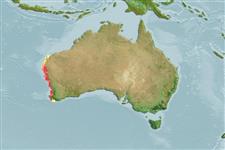Classification / Names
Noms communs | Synonymes | Catalog of Fishes(Genre, Espèce) | ITIS | CoL | WoRMS | Cloffa
>
Ophidiiformes (Cusk eels) >
Dinematichthyidae (Viviparous brotula)
Etymology: Zephyrichthys: Name from Latin 'zephyrus' for west wind, refers to the distribution along the west Australian coast; noun in apposition; barryi: Named for J. Barry Hutchins, WAM, Perth, Australia.
Eponymy: Dr J Barry Hutchins (d: 1946) was Curator of Fishes at the Western Australian Museum (1998–2007), which he joined as a Technical Officer (1972) and where he worked until he retired. [...] (Ref. 128868), visit book page.
More on authors: Schwarzhans & Møller.
Environment: milieu / climate zone / depth range / distribution range
Écologie
marin démersal; profondeur 0 - 15 m (Ref. 76869). Tropical
Eastern Indian Ocean: Western Australia.
Taille / Poids / Âge
Maturity: Lm ? range ? - ? cm
Max length : 5.9 cm SL mâle / non sexé; (Ref. 76869); 7.0 cm SL (female)
Description synthétique
Clés d'identification | Morphologie | Morphométrie
Rayons mous dorsaux (Total) : 86 - 99; Rayons mous anaux: 67 - 77; Vertèbres: 43 - 46. This species is distinguished by following set of characters: Anterior nostril positioned low on snout; copulatory organ of male with 2 pairs of pseudoclaspers, the outer one is wing-shaped with broad base, the inner one about half the size of the outer pseudoclasper, bifurcate, each branch with supporter, anteriorly joined to outer pseudoclasper; of moderate size, reaching to about 7.0 cm SL; usually 12-13 precaudal vertebrae, 43-46 total vertebrae; 7-8 branchiostegal rays; scale patch on cheek, usually 2-3 scales on operculum above opercular spine (rarely absent); no upper preopercular pore; otolith moderately compressed to elongate, its length to height is 2.1-2.3, sulcus not inclined, colliculi separated, caudal colliculum very short, the length of ostial colliculum to length of caudal colliculum is 5-8); maxilla expanded posterio-ventrally (Ref. 76869).
Life cycle and mating behavior
Maturité | Reproduction | Frai | Œufs | Fécondité | Larves
Schwarzhans, W. and P.R. Møller, 2007. Review of the Dinematichthyini (Teleostei: Bythitidae) of the Indo-west Pacific. Part III. Beaglichthys, Brosmolus, Monothrix and eight new genera with description of 20 new species. The Beagle, Records of the Museums and Art Galleries of the Northern Territory 23:29-110. (Ref. 76869)
Statut dans la liste rouge de l'IUCN (Ref. 130435: Version 2024-2)
Utilisations par l'homme
Outils
Articles particuliers
Télécharger en XML
Sources Internet
Estimates based on models
Preferred temperature (Ref.
123201): 17.7 - 23.3, mean 18.3 °C (based on 104 cells).
Phylogenetic diversity index (Ref.
82804): PD
50 = 1.0000 [Uniqueness, from 0.5 = low to 2.0 = high].
Bayesian length-weight: a=0.00389 (0.00180 - 0.00842), b=3.12 (2.94 - 3.30), in cm total length, based on all LWR estimates for this body shape (Ref.
93245).
Niveau trophique (Ref.
69278): 3.3 ±0.5 se; based on size and trophs of closest relatives
Fishing Vulnerability (Ref.
59153): Low vulnerability (10 of 100).
